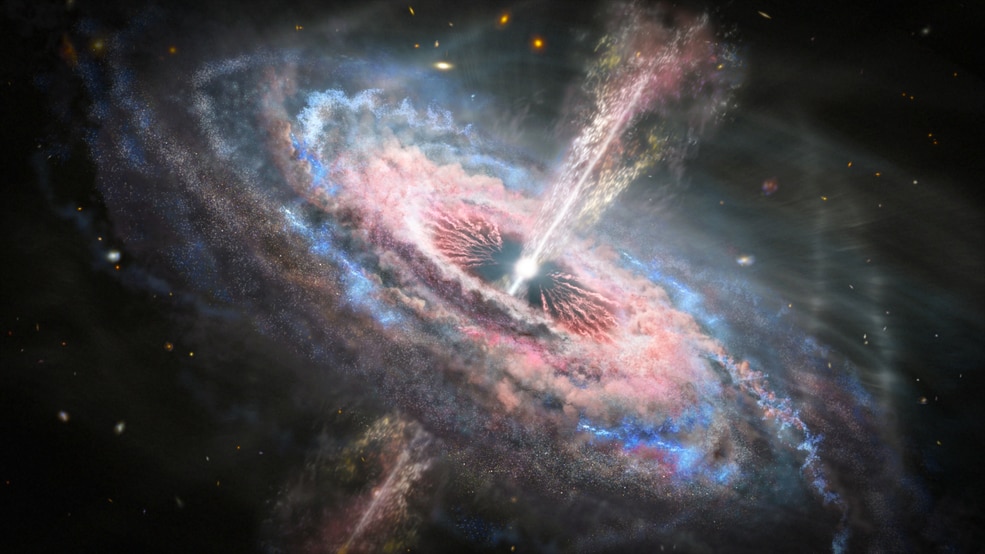Create a free profile to get unlimited access to exclusive videos, sweepstakes, and more!
Quasars could blow open what we still don’t know about the early universe

With the James Webb Space Telescope (finally) launching later this year, we will be able to see so far into space that we will be looking at the universe as it was when it was less than 800 million years old. In cosmic terms, that’s nothing.
The glow of objects from the depths of time has taken about 13 billion years to reach Earth. Webb will see them as they were when the universe was just emerging. When observed by the telescope, quasars from that era, some of the brightest objects in space, could shine light on the early stages of the galactic evolution, including the supermassive black holes that are thought to lurk at the centers of galaxies (unless they are actually globs of dark matter). It could change what we think we know about the beginning.
Chris Willott is one of the Canadian Space Agency’s Webb project scientists and a researcher at the Herzberg Astronomy and Astrophysics Research Centre of the National Research Council of Canada (NRC) in Victoria, British Columbia. He believes that Webb may see these quasars right when they had the most impact on their galaxies.
“We see black holes at a time when the universe was only 800 million years old that are almost as massive as the biggest we see today, so they evolved extremely early,” Willott tells SYFY WIRE. “By studying their galaxies, we can see what the impact of such extreme black holes is on the early formation of stars in these galaxies.”
Quasars are extremely compact and can be anywhere from hundreds of millions to billions of solar masses. Supermassive black holes in the galactic nucleus are thought to power them with star stuff that is swirling to its death in the black holes’ accretion discs -- which is why quasars are also too bright for any sunglasses. They tend to be over a hundred times brighter than their own galaxies. This may seem impossible because no light can escape a black hole. The thing is that friction happens as the guts of stars are gravitationally pulled towards the gaping maw of a supermassive black hole. That friction results in even more heat and light.
Observations have shown that there is a definite correlation between the masses of supermassive black holes and the masses of their galaxies. Monster black holes are found in gargantuan galaxies, lying in wait like spiders until unsuspecting stars and anything else passing too close gets caught by their gravity. Gases from all the stars in the galaxy feed these beasts and amp up the light of their quasars. What this correlation is probably telling us is that the heating and expulsion of gas from a quasar regulates how many stars are born in its galaxy.
Getting rid of gas prevents the formation of new stars, while jets of new gas could mean more star births. The quasars Webb observes will tell us things beyond that. Visibility was terrible in the early universe. It started off clear and full of ionized (electrically charged) gas for about 370,000 years after the Big Bang, but as the universe cooled, the gas neutralized and became foggy. The Epoch of Reionization was when that gas was ionized again and things cleared up. Willott believes there is a reason we can’t see any galaxies from this period in visible light.
“Before cosmic reionization, most hydrogen in the universe was atomic, so the electrons and protons are combined as atoms,” he says. “Atomic hydrogen absorbs ultraviolet radiation below a certain wavelength, so any light at those wavelengths will be absorbed by the hydrogen and won’t reach Earth. Due to the redshift effect on light, this ultraviolet radiation is shifted into the visible by the time it reaches us (and the visible light is shifted into the infrared).”
It is because of visible light shifting into the infrared that we cannot see extremely distant galaxies as they were during the Epoch of Reionization. Webb could help with beaming back data about gas in the intergalactic medium between the ancient galaxies it observes, revealing more about what really happened during that period. This is where quasars come in. It isn’t just hydrogen that absorbs light at certain wavelengths. The absorption lines in a quasar spectrum act like a series of fingerprints of the other elements floating around in that gas, which formed in dying stars and was then blown away by quasars.
Star stuff was also carried out by stellar winds or the immense forces generated by supernovas. Webb will be able to give us an unprecedented look at what the gas in the intergalactic medium was like, as well as how stars in the early universe took their proverbial last breaths. The telescope has a huge mirror to reflect more light and make faint objects more visible. It has excellent infrared optimization, so it can see objects at high redshifts. These are so distant that they can only be seen in infrared.
The new tech in Webb also includes integral field spectrographs and a multi-object spectrograph that will pick up on different spectra of light.
“We cannot detect stars in the galaxies around these distant quasars with current technology, even Hubble,” Willott says. “With Webb, we expect to see the stars and also the excited gas nebulae around these quasars to understand the impact the intense radiation from the quasar is having on the formation of stars in the galaxy.”















